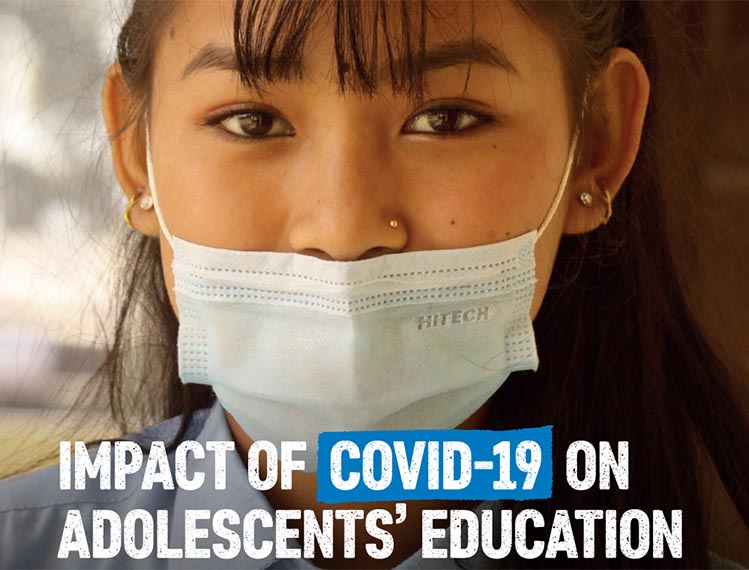IMPACT OF COVID-19 ON ADOLESCENTS’ EDUCATION WORLDWIDE

Education is critical to achieving gender justice, peace, stability and climate resilience
Education is a fundamental human right. Quality, equitable and inclusive education benefits individuals, communities and countries.
Education saves lives; improves nutrition; reduces child, early and forced marriage; and leads to more equal, respectful and open societies.
It is of grave concern, therefore, that the COVID-19 pandemic has created the worst education crisis in a century, affecting 94% of students worldwide.
At the pandemic’s peak in 2020, 1.6 billion students were taken out of the classroom. One in seven children globally have missed more than three quarters of their in-person learning since the start of the pandemic.
While swift and wide-ranging attempts were made to reach girls and boys through remote learning, nearly a third (463 million) were not able to access it – often lacking the necessary technological assets at home.
As a result, it is estimated that more than 100 million additional girls and boys will fall below the minimum proficiency level in reading.
This year of lost learning will have a damaging effect on the futures of millions.
The closure of schools has also prevented girls and boys from accessing protective spaces. Critical services such as school meals, menstrual hygiene kits, health services, and mental health and psychosocial support were suddenly out of reach.
Current evidence and experience shows the impacts of this are gendered, with girls and young women most affected through increased exposure to child, early and forced marriages; trafficking and sexual exploitation; and unintended or unwanted adolescent pregnancy.
The pandemic has exacerbated many pre-existing crises, including an education emergency that has resulted in high out-of-school rates, particularly among adolescents and young people, and a global learning crisis.
The climate emergency, humanitarian crises and conflicts are growing in complexity and length, further halting progress.xv COVID-19 has amplified these crises and knocked even further off course progress towards achieving Sustainable Development Goals 4 and 5 on education and gender equality, which was already lagging.
Millions of girls and boys risk missing out on an education unless ambitious action is taken. As it prepares to host the G7, the UK government has pledged to inject some “urgency” into the global education recovery.
This research on the “IMPACT OF COVID-19 ON ADOLESCENTS’ EDUCATION” provides an opportunity for adolescents to speak from their own perspectives, vividly portraying how COVID-19 has had a profound effect on their learning, motivation, mental health and wellbeing.
The findings present a stark insight into the challenges that adolescents, parents and teachers have faced over the past year as an already weak and overstretched education systems failed to adapt and cope with the sudden shift to remote learning:
- Nearly two-thirds of teachers were unable to teach remotely during lockdowns due to their own or their students’ lack of connectivity or access to devices. A lack of electronic devices, digital infrastructure and electricity meant most adolescents – particularly those in rural locations – were unable to access a quality education.
- Nearly nine in ten teachers reported fewer students attending online lessons compared with pre-pandemic school-based lessons.
- Fewer than a third of adolescents felt they learned as much at home as they would have in school. The home environment was generally not conducive to learning, with adolescents feeling easily distracted, unsupported, and limited in study time due to competing demands.
- More than a year since the pandemic began, six in ten adolescents have not yet fully returned to education. The reasons for this include more girls deciding, or being forced, to enter marriage or find work. Others did not return because they felt they had missed so much education they were unable or unwilling to catch up.
- The existing inequalities in the education system were exacerbated by the pandemic, particularly for girls, who face challenges unique to their intersecting experiences of gender and age.
- The social and economic impacts of the pandemic, isolation, concerns about the future, and stressful home-learning environments placed additional burdens on students, parents and caregivers. Adolescents reported significant impacts on their mental health and wellbeing.
- Nearly all adolescents want greater involvement in decisions about their education and how to respond to COVID-19 in their community.
Yasmin Qureshi MP, Labour’s Shadow International Development Minister, commenting on Plan International UKs report into the Impact of Covid-19 on Adolescent’s Education, said:
“All over the world, education has been drastically impacted by the pandemic. Home schooling has been a particular struggle for the most marginalised, and some students have received no education at all.
“As Britain hosts the G7 and the Global Partnership for Education summits, we have an opportunity to show true leadership to support access to education.
“The Government must reverse its decision to cut the aid budget and reaffirm its commitment to spending 0.7% of national income on supporting the world’s poorest and most vulnerable.”











Responses